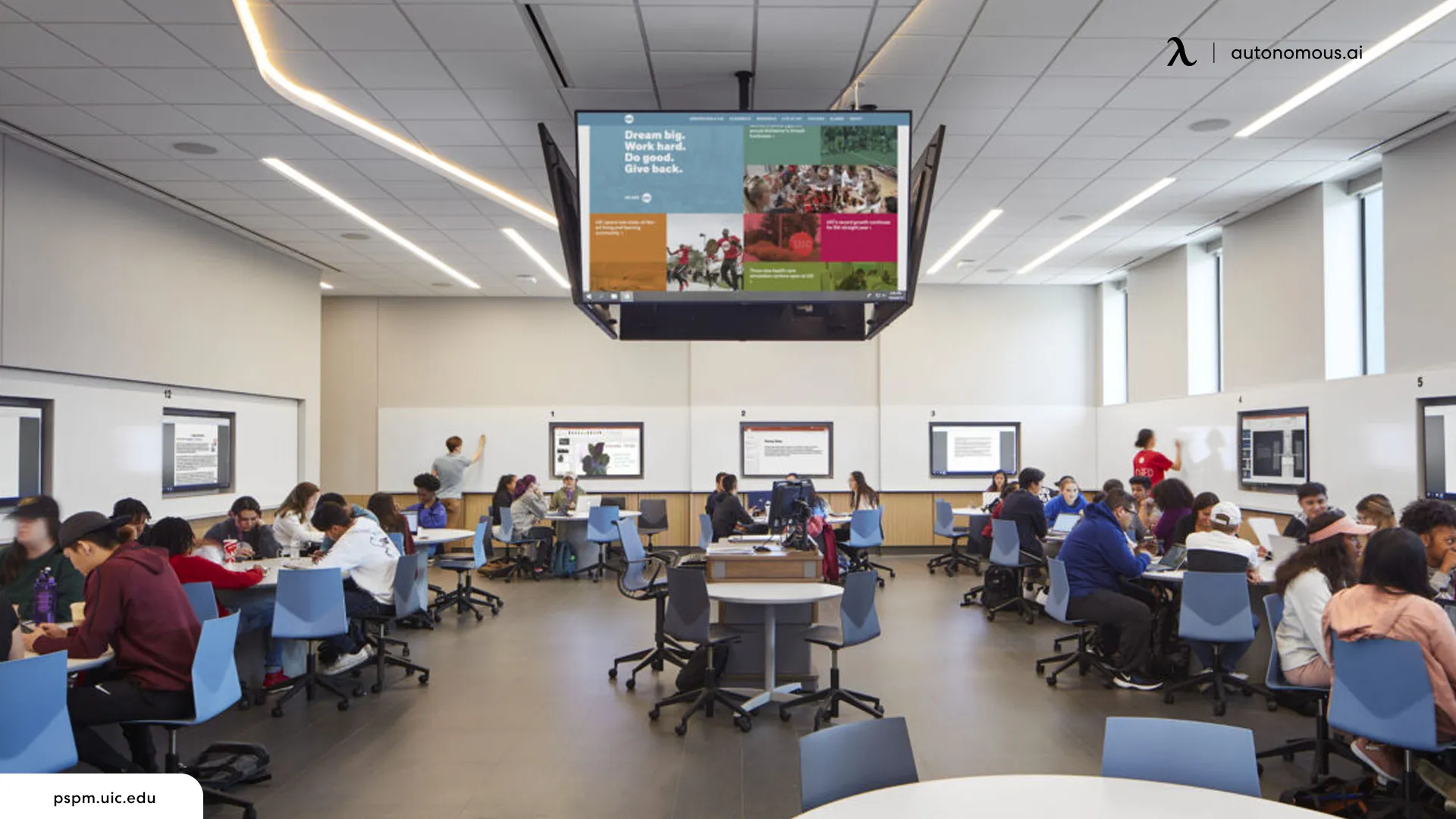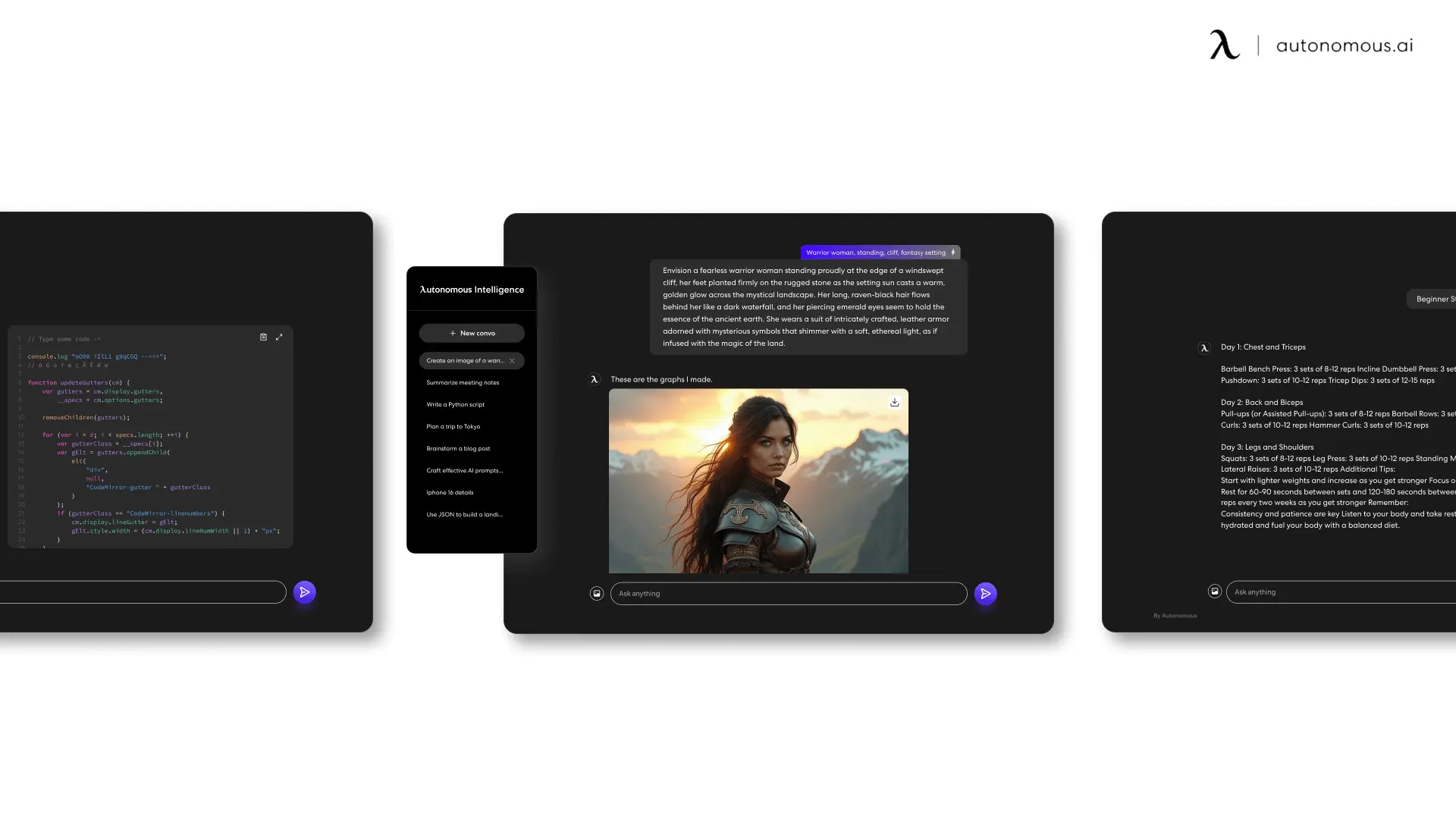
Table of Contents
AI tools are reshaping the classroom experience for educators by simplifying administrative tasks, enhancing lesson planning, and improving student engagement. In this article, we’ll cover the best AI tools for teachers in 2024, offering both free and premium options. These tools can save valuable time and help educators deliver more personalized and effective lessons. From AI assistants to design platforms like Canva, these resources are game-changers for the modern classroom.
How AI Tools Are Transforming the Classroom
AI is revolutionizing the way teachers manage their classrooms, plan lessons, and interact with students. With the help of AI tools for education, teachers can automate repetitive tasks such as grading, lesson planning, and content generation. Tools like TeachMateAI and Eduaide.Ai offer personalized assistance that saves time and ensures quality. By utilizing these AI tools for the classroom, teachers can focus more on engaging with students and less on administrative duties.
For a deeper dive into more versatile AI tools, check out our guide on the best AI tools available today.
Top 9 AI Tools Every Teacher Should Use in 2024
Here’s a list of the top AI tools every educator should be using to make the most of their time and deliver effective learning experiences:
1. DoMyEssay
The smart grammar checker to fix my essay is an AI-powered tool designed to help students improve the clarity, grammar, and structure of their essays. By analyzing your work for common errors like punctuation mistakes, spelling issues, and awkward phrasing, this tool ensures that your writing is polished and professional before submission.
Unlike traditional spellcheckers, this smart grammar checker goes beyond simple corrections. It provides suggestions for improving sentence flow, word choice, and overall readability, making your essay more coherent and engaging. Whether you're working on a school assignment or a professional report, this tool helps you produce flawless content with ease.
Who is it for: Students, writers, researchers
What is it for: It helps you check and correct grammar, punctuation, and style issues to ensure your writing is flawless and polished.
Tips to use:
- Use the tool to scan your essay multiple times for grammar and readability suggestions.
- Take advantage of the style recommendations to improve the flow of your writing.
- Ensure all punctuation is correct, particularly in long sentences where errors are common.
2. TeachMateAI
TeachMateAI is an AI-powered digital assistant designed by teachers and education technology experts to optimize classroom management, lesson planning, and grading. Its primary goal is to save educators time by automating repetitive administrative tasks.
TeachMateAI stands out due to its all-in-one platform that integrates multiple teaching tools into one space. Unlike other AI tools that focus solely on lesson planning or grading, TeachMateAI combines both, along with personalized feedback for students.
Who is it for: Teachers who need help with administrative tasks such as creating assignments, lesson plans, and grading.
What is it for: It helps teachers automate tasks like lesson creation, grading, and student feedback, providing more time for in-classroom engagement.
Tips to use:
- Use TeachMateAI to set up automated feedback for students based on their performance.
- Customize lesson templates to match curriculum standards and teaching styles.
3. Eduaide.Ai
Eduaide.Ai is a platform that assists educators in generating lesson plans, teaching resources, and assessments quickly. Its AI engine adapts to different teaching methods and subject areas, making it versatile for both K-12 and higher education.
Unlike other tools that offer general lesson planning assistance, Eduaide.Ai provides specific curriculum-aligned lesson plans based on national or state standards, making it especially valuable for public school educators.
Who is it for: Teachers and educators who want to streamline the lesson planning process, particularly those working in public or private institutions that follow strict curriculum guidelines.
What is it for: It’s ideal for generating customized lesson plans, worksheets, quizzes, and assessments tailored to various learning objectives.
Tips to use:
- Use Eduaide.Ai to generate differentiated lessons for various skill levels in the classroom.
- Export lesson plans directly to Google Docs or Slides for seamless integration with your existing tools.
4. Magic School AI
Magic School AI helps educators create lesson plans, assessments, and Individualized Education Programs (IEPs) while also managing differentiated learning needs. It’s designed to assist teachers in creating equitable learning environments.
Magic School AI is particularly strong in helping with special education needs, including writing IEPs and differentiating instruction. Other tools tend to focus solely on mainstream educational needs, but Magic School AI shines in creating personalized content for students with different learning abilities.
Who is it for: Teachers managing diverse classrooms or working with special education students who need tailored lesson plans and IEPs.
What is it for: It’s used for lesson planning, assessment writing, creating personalized learning plans, and managing student accommodations.
Tips to use:
- Use Magic School AI’s IEP writing feature to speed up the creation of personalized learning plans.
- Utilize the differentiated instruction templates for diverse classrooms to ensure every student gets the attention they need.
5. Brisk Teaching
Brisk Teaching is a free AI-powered Chrome extension that helps teachers manage their content creation directly within Google tools like Docs and Slides. It’s designed to assist with real-time content generation and lesson planning.
Unlike standalone platforms, Brisk Teaching integrates directly into tools teachers already use, like Google Workspace. It allows teachers to save time by enabling AI assistance without switching platforms.
Who is it for: Busy teachers who already use Google Docs, Sheets, and Slides for content creation and want a seamless, free AI tool to assist in real-time.
What is it for: It assists with creating lesson plans, quizzes, presentations, and classroom materials directly within Google Workspace.
Tips to use:
- Use Brisk Teaching’s quick prompts to generate lessons and quizzes on the fly during lesson prep.
- Collaborate with other teachers in real-time by sharing documents while using AI suggestions.
6. SchoolAI
SchoolAI is designed to help teachers save time by automating the creation of important classroom documents like lesson plans, worksheets, IEPs, and newsletters.
SchoolAI focuses heavily on document automation, making it a standout for teachers needing quick, efficient ways to create the necessary paperwork for daily classroom operations. It offers templates and AI-assisted customization to streamline document creation.
Who is it for: Teachers and school administrators looking for efficient solutions to generate important classroom documents like newsletters and worksheets.
What is it for: Document generation, lesson planning, worksheet creation, and classroom communication.
Tips to use:
- Set up SchoolAI to automate weekly newsletters to keep parents informed about classroom activities.
- Use its templates for quick generation of lesson plans and worksheets that match your teaching style.
7. ChatGPT
ChatGPT is an AI chatbot and virtual assistant capable of holding conversations and creating structured lesson plans. Its ability to adapt to different topics makes it a versatile tool for teachers.
ChatGPT offers conversational AI, which allows teachers to generate content interactively. It can be used for multiple purposes beyond education, which gives it a unique advantage over specialized AI tools that focus solely on teaching.
Who is it for: Teachers who need a flexible, general-purpose AI assistant that can assist with everything from lesson planning to answering student questions.
What is it for: It helps with creating lesson plans, drafting classroom materials, and holding virtual conversations to simulate student engagement.
Tips to use:
- Use ChatGPT to simulate student-teacher conversations for developing classroom scripts.
- Employ it as a brainstorming partner when developing new teaching strategies or lesson ideas.
For more about how to integrate AI tools into your teaching workflow, visit our guide on AI tools like ChatGPT.
8. Curipod
Curipod helps educators create engaging discussion prompts and interactive learning experiences that promote curiosity in the classroom.
Unlike most AI tools that focus on automating tasks, Curipod enhances student engagement by generating interactive learning content. It’s ideal for fostering discussions and making learning more dynamic.
Who is it for: Teachers who want to create interactive, curiosity-driven lessons and spark meaningful classroom discussions.
What is it for: Generating interactive content, discussion prompts, and sparking student engagement in the classroom.
Tips to use:
- Use Curipod to generate discussion topics that can help students think critically about subjects.
- Incorporate Curipod-generated content into group activities for increased classroom interaction.
9. Canva
Canva is a graphic design platform that allows teachers to create visually engaging presentations, handouts, and classroom posters with ease.
Unlike other tools that focus solely on educational content creation, Canva stands out with its rich visual design capabilities, enabling teachers to enhance the aesthetic appeal of their classroom materials.
Who is it for: Teachers looking to create professional, visually appealing teaching materials, including handouts, newsletters, and posters.
What is it for: Designing and creating graphic-rich classroom materials like presentations, posters, and newsletters.
Tips to use:
- Use Canva to create visually engaging presentations that capture students' attention.
- Explore Canva’s pre-built templates for quick creation of classroom posters and flyers.
10. Twee
Twee is an AI-powered tool that assists English teachers in creating questions from any YouTube video, generating dialogues, and creating reading materials.
Twee stands out by providing interactive tools for English teachers, specifically tailored for content creation around media and video content.
Who is it for: English teachers who want to create dynamic lesson plans and assessments based on multimedia resources.
What is it for: Generating questions, quizzes, and discussions from YouTube videos and other digital media.
Tips to use:
- Use Twee to create interactive quizzes for students based on educational videos.
- Generate dialogues or reading materials from online resources for classroom discussions.
For visual content creation, educators can also explore the best free AI image generators to bring lessons to life with customized images.
Autonomous Anon: An AI Solution for Educators
Autonomous Anon sets itself apart from other AI tools by focusing heavily on privacy and security while offering powerful assistance for educators. Unlike tools that store data externally, Autonomous Anon processes all information locally, ensuring your work remains private and secure.
- Privacy-First Approach: No sign-ins or data storage; all data stays within the browser, ensuring complete privacy.
- Intellectual Growth: Powered by the Llama 3.1 405B model, Autonomous Anon helps teachers think clearer, plan faster, and create better.
- Versatility: The tool can be used for a variety of tasks, including lesson planning, grading, and generating feedback.

Considerations for Using AI Tools in the Classroom
1. Defining Educational Goals
The first step in using AI tools in the classroom is to define clear educational objectives. Whether the goal is to enhance student engagement, improve writing skills, or make grading more efficient, AI tools should align with specific learning outcomes. For example, AI paraphrasing tools can assist students in refining their writing by offering suggestions on how to express ideas more clearly. However, it’s important that such tools are used to support learning rather than replace critical thinking or original work.
For instance, paraphrasing AI tools offer students opportunities to rephrase their writing while maintaining their own voice. Teachers can encourage students to use these tools to improve their writing without becoming overly reliant on them.
2. Data Privacy and Security
One of the most pressing concerns when integrating AI into education is the issue of data privacy. Many AI tools rely on large amounts of data to function effectively, raising questions about how student information is collected, stored, and used. Schools must ensure that any AI tool they adopt complies with relevant privacy laws, such as FERPA in the U.S. or GDPR in the European Union, to protect students’ sensitive information.
Educators should prioritize AI tools that guarantee data security and avoid platforms that could potentially misuse or sell student data. For example, tools like Autonomous Anon emphasize privacy by ensuring no data is stored externally, offering peace of mind for both students and educators.
3. Equity and Accessibility
When integrating AI into the classroom, it’s essential to consider issues of equity and accessibility. Not all students have equal access to the necessary technology or internet connectivity to fully utilize AI tools. Schools must ensure that any AI resources are accessible to all students, regardless of their socio-economic background. Additionally, AI tools should be user-friendly and adaptable to students with different learning needs, including those with disabilities.
Many AI tools, such as text-to-speech applications or tools that offer customizable learning experiences, can help make education more inclusive. By ensuring that all students can benefit from AI, educators can help close existing gaps in education.
4. Teacher Training and Familiarity
The successful implementation of AI in education hinges on teachers being adequately trained to use these tools. Schools must provide professional development opportunities that allow educators to understand how AI can complement their teaching and how to use these tools effectively in the classroom. Teachers should also be aware of the limitations of AI, ensuring that it serves as a supplement rather than a replacement for human instruction.
Moreover, teachers need to be prepared to guide students on how to use AI tools responsibly. For example, students might use AI-powered paraphrasing tools to improve their writing, but they should be taught to use these tools as aids for learning rather than shortcuts to completing assignments.
5. Ethical Considerations
AI tools in the classroom can sometimes introduce ethical challenges. AI systems are only as good as the data they are trained on, meaning they can inadvertently perpetuate biases present in that data. Educators need to evaluate the AI tools they adopt for potential biases and ensure that they promote fairness in student assessments.
Additionally, ethical use policies should be established to guide students on how to use AI tools responsibly. For example, while AI paraphrasing tools can be valuable in helping students improve their writing, they should be used with integrity to avoid plagiarism or over-reliance.
6. Cost and Long-Term Sustainability
AI tools can come with significant upfront and ongoing costs, from software licenses to necessary hardware upgrades. Schools need to consider whether these tools provide sufficient value to justify their cost. While some AI tools are free or have free versions, they may have limitations that necessitate upgrading to premium versions, which can strain school budgets.
It’s important for schools to evaluate the long-term sustainability of incorporating AI into the classroom. Some AI tools may offer short-term benefits but might not be scalable or adaptable as educational needs evolve. Careful consideration of both immediate and future costs is critical for making the most of AI technology.

FAQs
1. How can AI be used in education?
AI can assist teachers with tasks like grading, lesson planning, and personalized student feedback. It helps educators save time and allows them to focus more on student engagement.
2. How is AI used in education?
AI is used to automate administrative tasks, offer personalized learning experiences, and enhance student outcomes through data-driven insights.
3. What are the best AI tools for teachers?
Some of the best AI tools for teachers include TeachMateAI, Eduaide.Ai, and ChatGPT, which help with lesson planning, content creation, and classroom management.
4. Are there free AI tools for teachers?
Yes, tools like Brisk Teaching and Twee offer free versions that assist teachers in generating lesson materials and assessments.
5. Can AI tools help with grading?
Yes, many AI tools like SchoolAI offer grading assistance, automating the evaluation of quizzes, tests, and even essays.
6. How do AI tools improve lesson planning?
AI tools like Eduaide.Ai generate personalized lesson plans based on the curriculum, ensuring that educators can quickly create effective, engaging lessons.
7. How do AI tools help teachers in a hybrid or virtual classroom?
AI tools assist with virtual learning by providing real-time student feedback, managing assignments, and creating engaging online content.
8. What are the benefits of AI tools for education?
AI tools streamline administrative tasks, improve content quality, and offer personalized learning paths for students, making teaching more effective.
9. How can teachers ensure the privacy of student data while using AI tools?
Teachers should use AI tools like Autonomous Anon, which prioritize data privacy by ensuring that no information is stored on external servers.
10. What is the future of AI in education?
AI will likely become a staple in education, offering deeper personalization, more efficient administrative processes, and better student engagement in the future.

Conclusion
AI tools are rapidly becoming an essential part of the modern classroom. From simplifying lesson planning to improving grading efficiency, the best AI tools for educators help teachers focus on what really matters: engaging with their students. Whether you're looking for a free AI tool for education or something more advanced, there are plenty of options to choose from. Tools like TeachMateAI, Eduaide.Ai, and SchoolAI are transforming education, and with the rise of new AI technologies, the future of teaching looks brighter than ever.
For more comprehensive reviews, visit our guide on the best AI tools for writing or explore how to generate creative classroom visuals with AI tools for image generation.
Spread the word
.svg)







